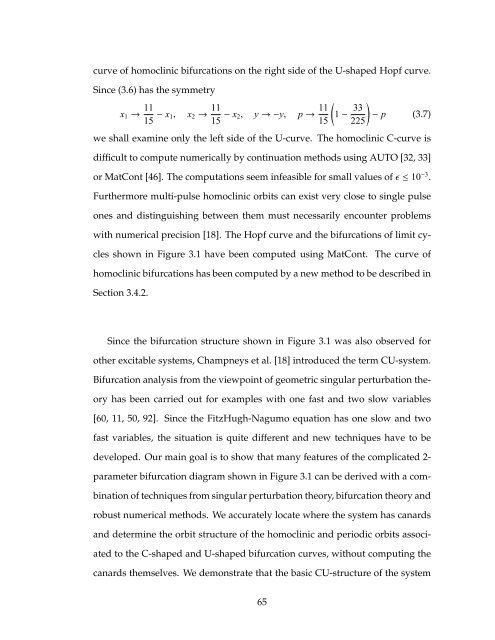multiple time scale dynamics with two fast variables and one slow ...
multiple time scale dynamics with two fast variables and one slow ...
multiple time scale dynamics with two fast variables and one slow ...
You also want an ePaper? Increase the reach of your titles
YUMPU automatically turns print PDFs into web optimized ePapers that Google loves.
curve of homoclinic bifurcations on the right side of the U-shaped Hopf curve.<br />
Since (3.6) has the symmetry<br />
x1→ 11<br />
15 − x1, x2→ 11<br />
15 − x2, y→−y, p→ 11<br />
15<br />
<br />
1− 33<br />
<br />
− p (3.7)<br />
225<br />
we shall examine only the left side of the U-curve. The homoclinic C-curve is<br />
difficult to compute numerically by continuation methods using AUTO [32, 33]<br />
or MatCont [46]. The computations seem infeasible for small values ofǫ≤ 10 −3 .<br />
Furthermore multi-pulse homoclinic orbits can exist very close to single pulse<br />
<strong>one</strong>s <strong>and</strong> distinguishing between them must necessarily encounter problems<br />
<strong>with</strong> numerical precision [18]. The Hopf curve <strong>and</strong> the bifurcations of limit cy-<br />
cles shown in Figure 3.1 have been computed using MatCont. The curve of<br />
homoclinic bifurcations has been computed by a new method to be described in<br />
Section 3.4.2.<br />
Since the bifurcation structure shown in Figure 3.1 was also observed for<br />
other excitable systems, Champneys et al. [18] introduced the term CU-system.<br />
Bifurcation analysis from the viewpoint of geometric singular perturbation the-<br />
ory has been carried out for examples <strong>with</strong> <strong>one</strong> <strong>fast</strong> <strong>and</strong> <strong>two</strong> <strong>slow</strong> <strong>variables</strong><br />
[60, 11, 50, 92]. Since the FitzHugh-Nagumo equation has <strong>one</strong> <strong>slow</strong> <strong>and</strong> <strong>two</strong><br />
<strong>fast</strong> <strong>variables</strong>, the situation is quite different <strong>and</strong> new techniques have to be<br />
developed. Our main goal is to show that many features of the complicated 2-<br />
parameter bifurcation diagram shown in Figure 3.1 can be derived <strong>with</strong> a com-<br />
bination of techniques from singular perturbation theory, bifurcation theory <strong>and</strong><br />
robust numerical methods. We accurately locate where the system has canards<br />
<strong>and</strong> determine the orbit structure of the homoclinic <strong>and</strong> periodic orbits associ-<br />
ated to the C-shaped <strong>and</strong> U-shaped bifurcation curves, <strong>with</strong>out computing the<br />
canards themselves. We demonstrate that the basic CU-structure of the system<br />
65
















